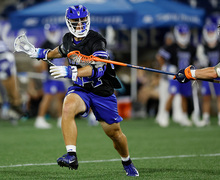Conventions show struggle for women to gain bylines in political writing
/ The Daily Orange
Not A Barbie Girl
Election season has officially been kicked into high gear. Last week, both the Democratic National Convention and Republican National Convention promoted their agendas and swung hard at each other.
If you weren’t able to catch any of the televised programs, chances are you were able to read about them in the news, and chances are that news article had a male byline.
A recent study released by the Women’s Media Center and the Fourth Estate Project revealed that men overwhelmingly outweigh women in 2012 election coverage. The survey consisted of national- and state-level newspapers with the country’s highest circulation rates, like The New York Times, The Washington Post, The Wall Street Journal and USA Today.
During the Republican Party primary period from January to April, men wrote 76 percent of articles. About 72 percent of campaign coverage was male-driven during the general election from April to August.
Nearly three-quarters of newspapers’ presidential coverage has failed to include female bylines. Despite these staggering statistics, this doesn’t necessarily come as a huge shock because women aren’t writing as many stories in general. The American Society of News Editors’ Newsroom Employment Census reported that 62 percent of reporters in newsrooms are men.
In 2011, two poets — Cate Marvin and Erin Belieu — spearheaded a count of bylines in national magazines like Harper’s, The New Yorker and The Atlantic. Between 65 and 75 percent of articles were authored by male writers, they found.
If there was any doubt left about the inequality of gender and bylines, the debate following the 2012 National Magazine Award finalists confirmed all previous suspicions. It was announced in April that there weren’t any women nominated in any of the major categories, such as reporting, features, profiles, essays and columns.
This started a conversation about female journalists only receiving recognition for what some analysts called “service” or “pink” writing about subjects concerning women’s issues. It’s hard to believe this issue is entirely based on a lack of interest from female journalists to cover politics and current events.
It’s important for more women to gain enthusiasm for political reporting and seek mentoring in this field within journalism, but it’s more important for those in positions of power to utilize their privilege and take matters into their own hands.
This is a deeply rooted issue that goes beyond individual journalists’ writing interests. There also needs to be an approach that battles the lack of female bylines on election coverage on a systemic level, in order to fully eradicate the imbalance of coverage.
Editors should seriously consider the immense lack of women journalists covering the 2012 election and work diligently to rectify this extreme imbalance. During an election in which a number of women’s rights issues — like health care, birth control access and wage equality— are at the center of campaigns and national concern, it only seems appropriate that news organizations create opportunities for females to write their fair share of coverage.
Krystie Yandoli is a senior women and gender studies and English and textual studies major. She can be reached at [email protected] or followed on Twitter at @KrystieLYandoli.
Published on September 10, 2012 at 1:00 am




